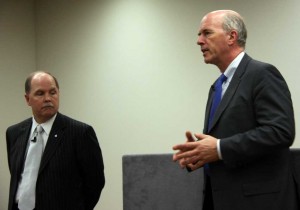
"There is no "Plan B,'" for our European operations insists GM President Fritz Henderson.
There is no “Plan B,” at least nothing that appears capable of saving General Motors European operations – and 300,000 jobs – other than a government bailout, insisted GM’s second-in-command.
The ailing U.S. automaker is ready to sell off a sizable stake in its vast Continental holdings in exchange for a bailout, which could come from the European Union, individual countries, such as Germany, or more likely a combination of the two, said Fritz Henderson, GM’s President, during a candid conversation at the Geneva Motor Show. The cash-strapped automaker would also consider an outsider investor, he noted, though Henderson warned it could take too long to put together such a deal to save GM Europe.
“We’ll be wide open to options,” Henderson said. “We’re in a situation where foreclosing options would be a luxury, unfortunately.”
The loss of GM’s European operations would be devastating to everyone concerned, noted Carl-Peter Forster, the CEO of that huge subsidiary. Not only would dozens of assembly and component plants be shuttered, but as many as 300,000 direct and indirect jobs – everywhere from assembly lines to showrooms – would be lost.

Up to 300,000 European jobs are at risk without help now, according to GM Europe President Carl-Peter Forster (r), and Fritz Henderson.
But even with government assistance, he added, “We have to restructure and we will restructure,” and that means a number of factories will close anyway. While GM officials declined to discuss specifics, industry insiders believe several assembly lines in the Netherlands, Germany and possibly Spain are particularly vulnerable.
And that could be one reason several individual governments are already anteing up cash to assist GM, such as Spain, which has committed $200 million, noted Forster, and could increase that figure. Since half of the automaker’s European workforce is in Germany, Forster pointed out, it is “natural” that GM is pressing that government for assistance, as well. And there are strong indications British leaders will authorize a bailout, as well.
Any European assistance would come separately from the bailout General Motors is seeking from the U.S. government. It got a multi-billion dollar loan, in December, and recently submitted a so-called “viability plan” to Washington in hopes of receiving additional cash – as early as April.
While GM has been in an aggressive global restructuring mode, for several years, the automaker seemed confident it could pull through on its own until the final quarter of 2008, but the sudden worsening of the U.S. economy, and the fact that the automotive slump, in particular, has now spread worldwide, meant it simply couldn’t cover its bills without outside help, said a clearly frustrated Henderson.
Skeptics fear that like the American banks, such as AIG and CitiCorp, GM might simply keep coming back for more handouts, but Henderson and Forster insisted the cash they’re seeking should carry them through the worst situation they could face.
“Knock on wood,” added the German executive, “we believe we may have found the bottom in Europe and we don’t have to continually reassess our forecast and adjust it downward.”
A bailout in Europe would not come without a price, the two company leaders acknowledged. It appears quite likely GM would have to surrender a stake in its European operations, perhaps as much as half – though German unions have suggested the automaker give up as much as 95 percent. Individual “stakeholders,” said Henderson, meaning specific governments, could seek other concessions, such as a promise not to eliminate jobs in their country.
“We haven’t taken any options off the table,” explained Henderson, “including (keeping a) majority (stake), minority or sharing.”
While some observers have suggested GM seek a non-government partner – another automaker, for example – Henderson suggested that option is unlikely to work, as it would take too long for such a buyer to do its due diligence and complete a transaction.
This and other alternatives, which might be called “Plan B,” stressed Forster, aren’t going to work.
“You’ve got to believe that most of these (300,000) jobs will be gone,” he lamented, “in Plan B.”
Asked about Saab, the Swedish-based subsidiary that was put into the Scandinavian equivalent of Chapter 11 reorganization, earlier this month, Henderson said, “I think there’s some interest in the brand,” by potential buyers, “but we’ll have to get the government funding,” in the form of a Swedish bailout, first.
Henderson said GM would be willing to take a number of steps to ensure Saab could survive after a sale, including an agreement to share any technologies needed to keep the long-troubled niche manufacturer competitive.
But time is clearly running out for Saab, he emphasized, adding that, “If it’s not able to reorganize, I goes into bankruptcy (and shuts down). That’s how it works.” And that’s the same fate that seems to be looming ever closer for the rest of GM’s European holdings.
“The first Plan B would be to try to survive and not run out of cash,” said Henderson, wrapping up a long discussion, but that, he quickly admitted, no longer seems possible.
